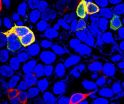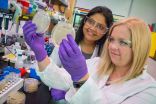IU researchers: Protein linked to aging identified as new target for controlling diabetes
2014-11-05
(Press-News.org) INDIANAPOLIS -- Indiana University School of Medicine researchers have identified a small protein with a big role in lowering plasma glucose and increasing insulin sensitivity. Their research appeared online today in Diabetes, the journal of the American Diabetes Association.
The report indicates that Sestrin 3 plays a critical role in regulating molecular pathways that control the production of glucose and insulin sensitivity in the liver, making it a logical target for drug development for type 2 diabetes and metabolic syndrome, which can produce increased blood pressure, abnormal cholesterol levels and insulin resistance.
Sestrin 3 is a member of a small family of proteins that have long been known to suppress oxidative stress and regulate normal cellular activity, thus making it an important regulator of metabolic homeostasis.
Lead author X. Charlie Dong, Ph.D., associate professor of biochemistry and molecular biology at the IU School of Medicine, and colleagues monitored blood glucose levels and liver insulin sensitivity in mice with the endogenous Sestrin 3 protein and mice genetically engineered to not produce the protein.
To examine the regulatory effects of Sestrin 3, the animals were fed a diet with 18 percent of its calories from fat or a high-fat diet with 60 percent of calories from fat. The mice without the Sestrin 3 protein had elevated fasting blood glucose levels, indicative of impaired liver insulin sensitivity or poorly regulated glucose metabolism. Both insulin and glucose tolerance tests were significantly better in the mice with the Sestrin 3 protein, leading researchers to believe that Sestrin 3 plays a critical role in hepatic insulin sensitivity and glucose metabolism.
"We wanted to show that Sestrin 3 had critical liver-specific functions," Dr. Dong said. "This is a very fascinating protein. It's not very big, but it functions in a very dynamic manner controlling glucose production and insulin sensitivity. It is an important regulator for glucose homeostasis."
Dr. Dong said the findings have significant implications in the prevention and treatment of type 2 diabetes and could prove to be useful targets for modulation of insulin sensitivity and glucose homeostasis and as a target for therapeutic agents to increase liver function to prevent diabetes.
INFORMATION:
This research was supported by RO1DK091592 from the National Institute of Diabetes and Digestive and Kidney Diseases, K08AA016570 from the National Institute on Alcohol Abuse and Alcoholism, and 1I01CX000361-01 from the U.S. Department of Veterans Affairs.
[Attachments] See images for this press release:

ELSE PRESS RELEASES FROM THIS DATE:
2014-11-05
Researchers from Northeastern University's Marine Science Center and the University of North Carolina at Chapel Hill have found that moderate ocean acidification and warming can actually enhance the growth rate of one reef-building coral species. Only under extreme acidification and thermal conditions did calcification decline.
Their work, which was published Wednesday in the journal Proceedings of the Royal Society B: Biological Sciences, is the first to show that some corals may benefit from moderate ocean acidification.
Justin Ries, an associate professor ...
2014-11-05
WASHINGTON, DC—November 4, 2014—An international team of bioengineers has boosted the ability of bacteria to produce isopentenol, a compound with desirable gasoline properties. The finding, published in mBio®, the online open-access journal of the American Society for Microbiology, is a significant step toward developing a bacterial strain that can yield industrial quantities of renewable bio-gasoline.
The metabolic engineering steps to produce short-chain alcohol solvents like isopentenol in the laboratory bacteria Escherichia coli have been worked on ...
2014-11-05
From water marks to colored threads, governments are constantly adding new features to paper money to stay one step ahead of counterfeiters. Now a longhorn beetle has inspired yet another way to foil cash fraud, as well as to produce colorful, changing billboards and art displays. In the journal ACS Nano, researchers report a new kind of ink that mimics the beetle's color-shifting ability in a way that would be long-lasting and difficult to copy.
Zhongze Gu, Zhuoying Xie, Chunwei Yuan and colleagues explain that some U.S. bills have color-changing features to help thwart ...
2014-11-05
Researchers from MIPT and the Weizmann Institute of Science (Israel) have predicted the possibility of negative turbophoresis, a phenomenon where impurity particles inside a turbulent flow move in an "impossible" direction. The study by Sergei Belan (a postgraduate at MIPT), Grigory Falkovich and Itzhak Fouxon was published in the journal Physical Review Letters in the Editors' Suggestions section, which features the most important and interesting studies from the editorial board's point of view.
The researchers studied the behavior of inertial particles in different ...
2014-11-05
An international study has devised a new measure for the "livability" of major cities across the world. The Global Liveable Cities Index (GLCI) takes into account the sensibilities of ordinary working people from 64 cities, balancing work and play, environmental awareness, localism, globalism and many other factors. Details are published in the World Review of Science, Technology and Sustainable Development.
According to Tan Khee Giap of the National University of Singapore and colleagues at University of California, Davis, and Curtin University, in Bentley, Australia, ...
2014-11-05
In a recent paper published in Nature Nanotechnology, Joel Moser and ICFO colleagues of the NanoOptoMechanics research group led by Prof. Adrian Bachtold, together with Marc Dykman (Michigan University), report on an experiment in which a carbon nanotube mechanical resonator exhibits quality factors of up to 5 million, 30 times better than the best quality factors measured in nanotubes to date.
Imagine that the host of a dinner party tries to get his guests' attention by giving a single tap of his oyster spoon on his crystal glass. Now, imagine, to the amazement of all, ...
2014-11-05
New Danish-led research suggests that signs of brain aging can be postponed in mice if placed on a high-fat diet. In the long term, this opens the possibility of treatment of children suffering from premature aging and patients with Alzheimer's and Parkinson's disease. The research project is headed by the Center for Healthy Aging, University of Copenhagen and the National Institute of Health.
When we get older, defects begin to develop in our nervous system, our brain loses some of its intellectual capacity, and the risk of developing diseases such as Parkinson's and ...
2014-11-05
Using DESY's ultrabright X-ray source PETRA III, researchers have observed in real-time how football-shaped carbon molecules arrange themselves into ultra-smooth layers. Together with theoretical simulations, the investigation reveals the fundamentals of this growth process for the first time in detail, as the team around Sebastian Bommel (DESY and Humboldt Universität zu Berlin) and Nicola Kleppmann (Technische Universität Berlin) reports in the scientific journal Nature Communications. This knowledge will eventually enable scientists to tailor nanostructures ...
2014-11-05
Researchers at the Cognition and Brain Plasticity group of the Bellvitge Biomedical Research Institute (IDIBELL) and the University of Barcelona have been tracking the traces of implicit and explicit memories of fear in human. The study has been published in the journal Neurobiology of Learning and Memory and describes how in a context of fear, our brain differently encodes contextual memory of a negative event (the place, what we saw...) and emotional response associated.
The study measures electrodermal activity of 86 individuals in a fearful generated in the laboratory ...
2014-11-05
Bethesda, MD (Nov. 5, 2014) — Up to 15 percent of the general adult population is affected by irritable bowel syndrome (IBS), and most patients struggle to find effective drug therapy. A new guideline from the American Gastroenterological Association (AGA) provides these patients and their physician's guidance. The new guideline and accompanying technical review have been published in Gastroenterology, the official journal of the AGA Institute.
"Because no IBS therapy is uniformly effective, many patients describe a history of a variety of treatments alone or in ...
LAST 30 PRESS RELEASES:
[Press-News.org] IU researchers: Protein linked to aging identified as new target for controlling diabetes






